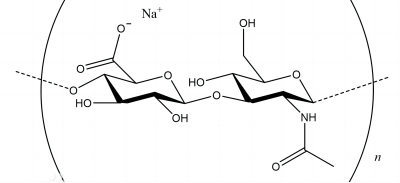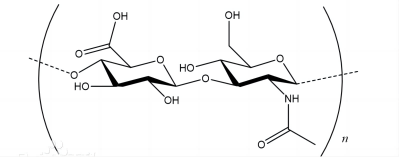Sodium Hyaluronate Vs Hyaluronic Acid
| Product name | Sodium Hyaluronate | Hyaluronic Acid |
| INCI name | SODIUM HYALURONATE | HYALURONIC ACID |
| CAS no. | 9067-32-7 | 9004-61-9 |
| ph | 5.0-8.5 | 3.0-5.0 |
| Molecular Weight | 1000-2.3 million | Below 0.1 million |
| Molecular Formula | (C14H20NO11Na)n | (C14H21NO11)n |
| Molecular Structure |  |
 |
| Stability | Better | Weaker |
| Sodium hyaluronate is the sodium salt form of hyaluronic acid | ||
First, hyaluronic acid ≠sodium hyaluronate
Hyaluronic acid and sodium hyaluronate are listed in the “Catalog of Used Cosmetic Ingredients” published by China in 2021. From the CAS number, sodium hyaluronate CAS number is 9067-32-7, while hyaluronic acid CAS number is 9004-61-9.
What is hyaluronic acid? What is sodium hyaluronate?
Hyaluronic acid is acid, sodium hyaluronate is sodium salt, sodium hyaluronate is actually the sodium salt form of hyaluronic acid, strictly speaking, hyaluronic acid actually belongs to the acid, and sodium hyaluronate belongs to the sodium salt, the two are different substances. From the molecular structure, the two have the same main structure, the difference lies in the carboxyl group R position is connected to the hydrogen ion, it is hyaluronic acid, connected to the sodium ion, it is sodium hyaluronate. The pH of hyaluronic acid is low, 3.0-5.0, and the pH of sodium hyaluronate is close to neutral, generally 5.0-8.5.
The application of hyaluronic acid and sodium hyaluronate
Hyaluronic acid and sodium hyaluronate actually belong to large molecules of polysaccharides, with a very strong moisturizing, the difference is that the two are due to structural differences, resulting in a greater difference in the nature of the product, hyaluronic acid ph is 3.0-5.0, due to its lower pH resulting in poor product stability, molecular weight degradation at room temperature faster; molecular weight is basically below 100,000; the production process is also more complex than sodium hyaluronate. The pH of hyaluronic acid is lower, acidity leads to a certain degree of irritation, limiting the application of the product, so it is not common in the market. Sodium hyaluronate is stable, the production process is mature, the pH is nearly neutral and basically non-irritating, the molecular weight range is wide, 1000-2.3 million can be produced to meet the different needs of the market, so it is widely used in the market. Hyaluronic acid is generally referred to in the publicity of our common cosmetic products and food products, but actually it’s sodium hyaluronate, people is used to call it hyaluronic acid.
As can be seen from the above, hyaluronic acid and sodium hyaluronate is not essentially a product. But we all habitually call sodium hyaluronate hyaluronic acid, resulting in many misunderstandings.
How to distinguish between hyaluronic acid and sodium hyaluronate
According to the relevant laws and regulations of cosmetics, all kinds of specific ingredients of cosmetics can be distinguished by the ingredient list on the back of cosmetic products.
At present, only sodium hyaluronate is approved to be used in China’s new resource food, while both hyaluronic acid and sodium hyaluronate can be used as feed additives in pet food.
The efficacy of sodium hyaluronate
Sodium hyaluronate with its unique molecular structure and physicochemical properties in the body shows a variety of important physiological functions, such as lubrication of joints, regulating the permeability of blood vessel walls, regulating proteins, water-electrolyte diffusion and functioning, and promote trauma healing. At the same time it is an important foundation material for skin hydration, itself a component of the human body, it has a special water-retaining effect, is one of the best moisturizing substances found in nature. It can improve the skin nutrition metabolism, make the skin soft, smooth, wrinkle, increase elasticity, to prevent aging, in the moisturizing and at the same time can assist other components of the transdermal absorption of the promoter.
Related reading:







